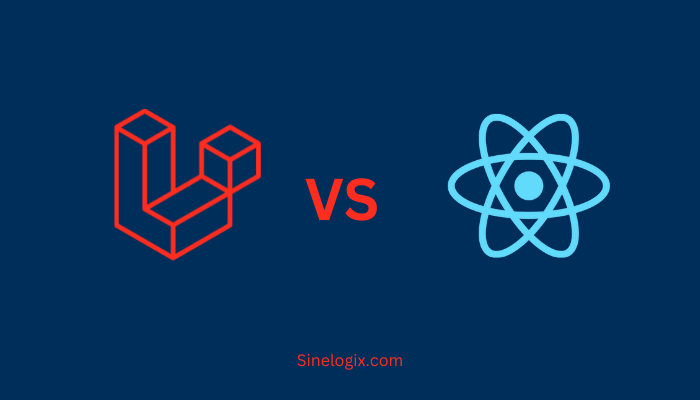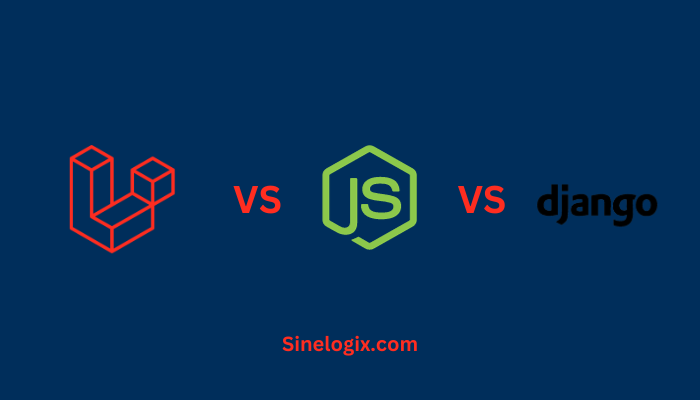In the dynamic realm of web development, selecting the appropriate technology stack is pivotal for constructing robust and scalable applications. Laravel and React, two key players in this space, offer distinctive advantages and capabilities.
This article aims to provide an in-depth analysis of Laravel, a PHP-based backend framework, and React, a JavaScript library for building user interfaces, covering various aspects to aid developers in making informed decisions for their projects.
1. Overview of Laravel and React
Laravel: Laravel, an open-source PHP web application framework, is renowned for its elegant syntax, developer-friendly features, and the robustness it brings to web development. It follows the MVC (Model-View-Controller) architectural pattern, promoting code organization and maintainability.
React: Developed by Facebook, React is a JavaScript library for building user interfaces. It enables developers to create reusable UI components, facilitating the development of interactive and dynamic user interfaces. React follows a declarative approach, making it efficient for managing the state of an application.
2. Language and Ecosystem
Laravel: Laravel is built on PHP, a widely-used server-side scripting language known for its simplicity and ease of learning. Laravel’s ecosystem includes Composer for package management, Eloquent ORM for database operations, and Blade templating engine for dynamic views.
React: React is written in JavaScript, a language that powers the web. Its ecosystem includes Node.js for server-side rendering, npm for package management, and a wide array of libraries and tools such as Redux for state management and React Router for handling navigation.
3. Architecture and Scalability
Laravel: Laravel’s MVC architecture promotes clean separation of concerns, making it easy to manage and scale applications. It comes with built-in support for caching, queuing, and database migrations, enhancing the scalability of Laravel applications.
React: React’s component-based architecture encourages reusability, simplifying the development process. While React itself is focused on the view layer, it can be seamlessly integrated with other libraries and frameworks for building scalable applications.
4. Learning Curve and Documentation
Laravel: Laravel is known for its developer-friendly syntax and comprehensive documentation. The Laravel community actively contributes to tutorials, forums, and documentation, making it easier for developers to get started and resolve issues.
React: React’s learning curve can be steeper for beginners, especially those new to JavaScript or modern frontend development concepts. However, React’s documentation is thorough, and the community support is robust, with a wealth of resources available for learning.
5. Community and Support
Laravel: Laravel boasts a vibrant and active community, contributing to the framework’s growth and development. The Laravel ecosystem includes Laracasts, a platform for Laravel-focused screencasts, and numerous packages created by the community.
React: React has a massive community of developers and is widely adopted by companies around the world. The React community actively contributes to the library’s development, and resources like React’s official documentation, Stack Overflow, and various online forums provide ample support.
6. Performance
Laravel: Laravel offers good performance out of the box, and its performance can be further optimized by leveraging features like caching, queuing, and optimizing database queries. Laravel applications can be scaled horizontally by adding more servers to handle increased traffic.
React: React’s virtual DOM enables efficient updates to the user interface, resulting in better performance. React applications can be optimized using techniques like code splitting and server-side rendering (SSR) to improve initial page load times.
7. Use Cases and Industry Adoption
Laravel: Laravel is widely used for building a variety of web applications, including content management systems (CMS), e-commerce platforms, and enterprise-level applications. It has gained popularity in the PHP community and is trusted by developers for its reliability.
React: React is extensively used for building dynamic and interactive user interfaces in single-page applications (SPAs). It is a popular choice for frontend development in conjunction with other libraries and frameworks. React is employed by many tech giants, including Facebook, Instagram, and Airbnb.
8. Integration and Flexibility
Laravel: Laravel supports seamless integration with various third-party services and tools. It provides an elegant syntax for routing, making API development straightforward. Laravel Passport and Sanctum are packages that facilitate API authentication.
React: React can be integrated into existing projects or paired with other frontend technologies. It excels in building single-page applications and can be used in combination with state management libraries like Redux for more complex applications.
9. Testing and Quality Assurance
Laravel: Laravel emphasizes testing with PHPUnit, providing a robust testing environment out of the box. Developers can conduct unit tests, feature tests, and integration tests seamlessly. Laravel Dusk facilitates browser automation testing, ensuring comprehensive coverage for web applications.
React: React promotes the use of testing libraries like Jest and Enzyme. Jest offers a fast and reliable test runner, while Enzyme simplifies the testing of React components. The React testing ecosystem allows for effective unit testing and component testing, ensuring the stability of the frontend.
10. Development Speed and Prototyping
Laravel: Laravel’s elegant syntax and built-in features like Eloquent ORM and Blade templating engine contribute to rapid development. Laravel Spark, a package for SaaS application scaffolding, accelerates the creation of subscription-based web applications, making it ideal for startups and rapid prototyping.
React: React’s component-based architecture fosters rapid development, especially for single-page applications. Tools like Create React App enable developers to set up a React project quickly. React’s virtual DOM enhances the efficiency of UI updates, contributing to a smoother development experience.
11. Mobile App Development
Laravel: While Laravel is primarily a backend framework, it can be used in conjunction with technologies like Laravel Nova or API resources to serve as the backend for mobile applications. Laravel’s API-centric approach facilitates the development of robust and secure APIs for mobile app integration.
React: React Native, an extension of React, is a popular choice for building cross-platform mobile applications. Developers can leverage their React skills to create native mobile apps for iOS and Android, offering a consistent user experience across different platforms.
12. Community Trends and Future Outlook
Laravel: The Laravel community is dynamic, and the framework continues to evolve with frequent updates and new features. Laravel Vapor, a serverless deployment platform, reflects the community’s commitment to embracing modern cloud-native technologies, ensuring Laravel remains relevant in the serverless era.
React: React maintains its position as a leading library for frontend development. The React team regularly releases updates and improvements, and the community actively contributes to the ecosystem. The adoption of React in emerging technologies, such as virtual reality (React 360) and server-side rendering, showcases its adaptability and future potential.
13. Security Features
Laravel: Laravel prioritizes security with features like hashed passwords, CSRF protection, and the Eloquent ORM that helps prevent SQL injection attacks. Laravel Sanctum provides a simple and convenient way to authenticate APIs, ensuring secure communication between frontend and backend.
React: React focuses more on the view layer and UI components rather than security directly. Security measures for React applications are often implemented on the server-side, emphasizing the importance of a secure backend, such as Laravel, when integrating with React.
14. Development Team Skill Set
Laravel: Laravel is well-suited for developers with PHP expertise. Its syntax and conventions are designed to enhance developer productivity, making it an excellent choice for teams experienced in PHP and wanting to build modern, scalable web applications.
React: React is ideal for frontend developers with strong JavaScript skills. It is commonly used with technologies like webpack and Babel, and understanding concepts like JSX and virtual DOM is crucial. Teams specializing in modern frontend development often find React to be a natural fit for their skill set.
15. Extensibility and Customization
Laravel: Laravel encourages extensibility through Composer packages, allowing developers to easily integrate third-party libraries and tools into their applications. Laravel’s modular structure and artisan command-line tool simplify customization, enabling developers to tailor the framework to meet specific project needs.
React: React’s component-based architecture fosters a high level of modularity and reusability. Developers can create custom components and easily reuse them across the application. The rich ecosystem of npm packages provides a plethora of tools for extending React’s capabilities, allowing for efficient customization.
16. Internationalization and Localization
Laravel: Laravel provides robust support for internationalization and localization through its built-in features. Developers can easily manage language files, translate content, and adapt the application to different locales. Laravel’s localization capabilities contribute to building globally accessible web applications.
React: React itself does not offer built-in internationalization support, but developers can utilize third-party libraries like react-intl for managing translations and handling localization in React applications. This allows for flexibility in adapting the user interface to diverse language requirements.
17. Documentation and Educational Resources
Laravel: Laravel is acclaimed for its comprehensive documentation, providing in-depth guides, API references, and tutorials. The Laravel community actively contributes to educational resources, including Laracasts, which offers video tutorials covering various aspects of Laravel development, making it an excellent learning resource.
React: React’s official documentation is extensive and well-maintained, covering the library’s core concepts and features. Additionally, the React community produces a wealth of educational content, including online courses, blog posts, and video tutorials. Platforms like Codecademy and freeCodeCamp offer interactive React courses for beginners.
18. Community Packages and Libraries
Laravel: Laravel’s package manager, Composer, enables developers to integrate a wide array of community-contributed packages seamlessly. The Laravel ecosystem includes packages for various functionalities, such as authentication, image processing, and API development. Laravel Nova, a premium administration panel, further extends Laravel’s capabilities.
React: The npm registry hosts a vast collection of JavaScript libraries and packages that complement React development. Redux, for state management, React Router for navigation, and Axios for HTTP requests are among the popular libraries used with React. The availability of these packages enhances the development experience and accelerates project timelines.
19. Community Events and Conferences
Laravel: The Laravel community organizes events like Laracon, an annual conference dedicated to Laravel. These events provide opportunities for developers to connect, learn about the latest developments in the Laravel ecosystem, and gain insights from industry experts.
React: The React community participates in events such as React Conf, a conference where developers can explore new React features, best practices, and real-world use cases. Attendance at these events can be valuable for staying updated on React trends and networking with fellow developers.
20. Long-Term Support and Stability
Laravel: Laravel follows a release cycle with LTS (Long-Term Support) versions, ensuring stability and security updates for an extended period. This approach is beneficial for projects requiring long-term maintenance and support, providing a reliable foundation for mission-critical applications.
React: React’s commitment to backward compatibility and gradual adoption of new features ensures stability for existing applications. The library’s development team maintains a balance between innovation and stability, making it suitable for projects with a focus on long-term sustainability.
Related Articles:
Conclusion
In the Laravel vs. React debate, the choice ultimately depends on the specific requirements of the project and the expertise of the development team.
Laravel excels in backend development, offering a robust framework for building scalable and maintainable applications. On the other hand, React is a powerful tool for crafting dynamic user interfaces with a focus on component-based architecture.
By considering factors such as language preference, scalability needs, and project requirements, developers can make an informed decision on whether to choose Laravel, React, or a combination of both for a full-stack solution.
Ultimately, the success of a project lies in understanding the strengths and weaknesses of each technology and leveraging them effectively to achieve the desired outcomes.




